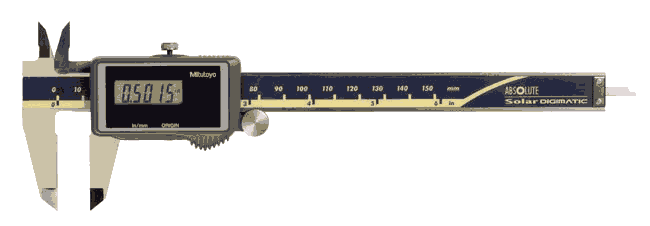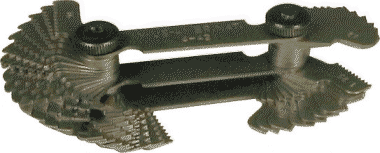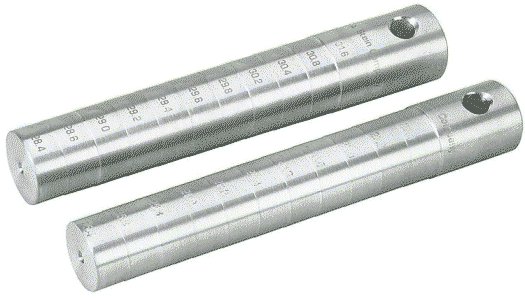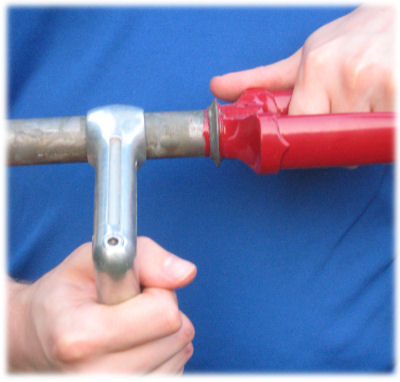Kunstgriffe beim Messen: Unterschied zwischen den Versionen
K (→Gabelshaft und Vorbau: typo) |
(→Lenker- und Vorbaudurchmesser: übersetzt) |
||
| Zeile 57: | Zeile 57: | ||
===Lenker- und Vorbaudurchmesser=== | ===Lenker- und Vorbaudurchmesser=== | ||
[[Bild:Stem-diameter.JPG|Vorbaumaß mit einem Gabelschaft bestimmen|right]] | |||
Die meisten lenker haben in der Mitte einen größeren Durchmesser und verjüngen sich zu den Enden hin. Standardgrößen findet man in der [[Lenkerklemmmaße (Tabelle)|Tabelle über Lenkerklemmmaße]]. Die meisten Größen sind geläufige Zollmaße und können (wenn vorhanden) mit einem zollbasierten Schlüssel geprüft werden. | |||
Das gängigste Lenkerklemmmaß ist 1 Zoll (25,4 mm), das auch dem Maß eines normalen britischen oder italienischen Gabelschafts entspricht. Man kann das also Vorbaumaß prüfen, indem man den Vorbau auf den Gabelschaft aufschiebt. Das geht schneller als den Vorbau mit dem [[Dropbar]] zu verschrauben. Auch könnte man sich ein Stück eines Oberrohrs eines defekten Stahlrahmens heraus sägen und bereit legen. | |||
Das Lenkerklemmmaß für veraltete französische Lenker ist 25,0 mm und wird sich nicht über den Gabelschaft schieben lassen. Es gibt drei verschiedene italienische Größen, die etwas mehr als 1 Zoll messen, die dann sehr lose passen. Hier sollte man die Marken des Vorbaus und des Lenkers vor dem Zusammenbau prüfen. Der Vorbau sollte sich leicht über den Lenker schieben lassen bis er festgeschraubt wird. | |||
Verbreitete Maße für Lenkerenden sind 22,2 mm (7/8 Zoll) für flache und 23,8 mm (15/16 Zoll) für Dropbar-Lenker. Das gilt auch für alle italienischen Lenkermodelle. Die meisten [[Schalthebel]] für [[Nabenschaltung]]en und [[Drehgriffschalter]] passen ausschließlich bei flachen Lenkern. Einen Schalthebel überschieben hilft meistens den Durchmesser des Lenkerendes zu bestimmen. 22.2. mm ist gleichzeitig auch der Außendurchmesser eines [[Vorbauschaft]]s (Vorbau für Gewindesteuersätze). So kann man also das Lenkerende in einen 1 Zoll Gabelschaft für Gewindesteuersätze einführen, um das Lenkerendemaß zu bestimmen. | |||
==Innere Maße== | ==Innere Maße== | ||
Version vom 11. März 2016, 06:45 Uhr
Präzises Messen ist oft notwendig, wenn man sicher stellen möchte, dass Fahrradteile zueinander passen. Normalerweise werden solche Messungen mit speziellen Messinstrumenten durchgeführt, die man nicht unterwegs mit sich herum trägt. Meistens haben diese Instrumenete genau einen Einsatzzweck und sich vergleichsweise teuer.
Sichlich sollte man ein Maßband für größere Messungen besitzen, um Rahmenhöhe, Felgendurchmesser oder Abrollumfang messen zu können. Ein Lineal ist für viele Messungen ausreichend. Jedoch hat keines dieser Messinstrumente die Genauigkeit, die notwendig ist, um Fahrradkomponenten auf Kompatibilität zu prüfen.
Exaktes Messen
Um die Aufgabe besser zu erstehen, schauen wir uns zuerst ein paar Messinstrumente an, die man normalerweise nicht mit sich führt und die man auch nicht in der heimischen Werkstatt hat, falls man Heimwerker ist. Die gute Nachricht ist, dass man oft gängiges Werkzeug oder Fahrradteile selbst benutzen kann, um die notwendigen Maße zu nehmen. Oft kann man zu Kunstgriffen greifen, um Zeit zu sparen. In diesem Artikel werden einige dieser Techniken erläutert. Am Ende des Artikels folgt eine Liste mit anderen Artikeln, die sich im weitesten Sinne mit Messungen beschäftigen.
Messschieber
Der Messschieber ist ein vielseitiges und sehr präzises Messwerkzeug für Innen-, Außen- und Tiefenmessungen. Die nützlichsten haben eine Digitalanzeige, die zwischen Zollmaß und metrischem Maß per Knopfdruck umgeschaltet werden kann. Normalerweise nimmt man einen Messschieber nicht auf dem Fahrrad mit. Es gibt allerdings andere Wege die notwendigen Maße am Fahrrad zu nehmen.
Gewindelehre
Die Gewindelehre mit sägezahnbestückten Fühlern ist für Mechaniker oder Automechaniker wichtig. Sie ist für den Gebrauch am Fahrrad eigentlich zu vielseitig und dadurch viel zu teuer. Das im Bild gezeigte Werkzeug hat zwei Taschen. In der einen Tasche sind Fühler für ISO (metrische) Gewindemaße und in der zweiten Tasche sind Fühler für SAE (zollbasierte) Maße - jedoch nur wenige verschiedene Größen. In diesem Artikel wird gezeigt, wie man andere Fahrradteile benutzen kann, um Gewindemaße zu prüfen.
Stein Sattelrohr-Innenmaßlehre
Der Innendurchmesser der meisten Fahrradteile, bei denen präzise Passform benötigt wird, ist mit wenigen Variationen standardisiert. Beim Sattelrohr jedoch ist der Außendurchmesser standardisiert aber die Innenmaße sind es nicht.
Diese Werkzeuge der Firma Stein können für ein schnelles Maßnehmen des Sattelrohrinnendurchmessers genommen werden. Auch kann das Innenmaß eines Gabelkonus bestimmt werden. Man kann mit ihnen auch einen Außendurchmesser bestimmen, indem man sie mit einem Engländer benutzt. In einer Fahrradwerkstatt machen sie sich schnell bezahlt, aber für den persönlichen Gebrauch sind sie zu schwer und zu teuer.
Weniger bequem kann ein Messschieber die gleichen Maße bestimmen. Wenn man weder die Stein Instrumente noch einen Messschieber zur Hand hat, kann man die Maße einer alten und einer Ersatzsattelstütze vergleichen. Dieses Vorgehen wird im Artikel beschrieben.
Außenmaßbestimmung mit einem Schlüssel
Maulschlüssel können zum direkten Messen von AUßenmaßen mittels Ihrer eigenen Größe benutzt werden. Obwohl die meisten Muttern und Schrauben bei Fahrrädern metrisches Maß haben, sind viele Standarddimensionen von Fahrradteilen in Zoll angegeben. Daher können zollbasierte Schlüssel zum direkten Messen verwendet werden, die leider in Europa schwer erhältlich sind.
Ein Engländer kann jedoch nicht zum direkten Messen verwendet werden. Man kann jedoch zwei teile mit ihm direkt präzise vergleichen. Zumeist ist es auch das, was man öfter benötigt. Für die meisten solcher Vergleichsmessungen benötigt man einen 10 Zoll Engländer, der sich mehr als 1 Zoll (2,54 cm) öffnen lässt. Man sollte sowieso einen solchen in seiner Werkstatt haben, wenn man mal wieder auf eine Vorbauschraube mit ungewöhnlichem Maß trifft.
Schraubzwingen können ebenfalls zum Vergleich zweier Bauteile herangezogen werden, indem man die Spannarme so weit zusammenschraubt, dass das eine Bauteil gerade noch so herausziehbar ist.
Vierkantaufnahmen von Innenlagerwellen
Ein 13 mm (bzw. 1/2 Zoll) Maulschlüssel kann zum Vergleich der Vierkantaufnahme einer Innenlagerwelle benutzt werden. Schiebe den Schlüssel auf die Vierkantaufnahme bis es nicht mehr weiter geht. So erkennt man direkt wie weit der Schlüssel sich aufschieben lässt (s. Bilder). Die linke Welle ist eine Sugino MW-70 - sehr wahrscheinlich eine NJS Welle, vergleichbar mit eine älteren Campagnolo Welle. Die rechte Welle ist eine JIS (Japan Industrial Standard) Welle.
Ein Engländer kann dazu benutzt werden, zwei Wellen zu vergleichen, kann jedoch nicht zum Bestimmen von NJS oder JIS Wellen benutzt werden. Beim Vergleichen sollte man mit dem Daumen nach der ersten Messung das Verstellen des Schlüssels verhindern.
Andere Kurbelwellenmaße
Die Lagersitze von Wellen einiger Patronenlager unterschieden sich leicht in ihrem Durchmesser und können mit einem Engländer verglichen werden. Das gleiche gilt für Wellen mit Splintbefestigung. Französische Wellen mit Splintbefestigung haben einen Durchmesser von 15,5 mm (0,610 Zoll) und die meisten anderen Modelle 15,88 mm (0,625 Zoll) - das liegt zu nah beieinander, um mit bloßem Auge erkennbar zu sein. Wenn man einen Schlüssel zum Vergleich benutzt, wird es offensichtlich.
Die Passgenauigkeit von klassischen Konusinnenlagern kann mit Einsatz von ein wenig Fett geprüft werden. Das wird im Artikel Fragen zu Gewinden und Austauschbarkeiten bei älteren Raleigh Fahrrädern beschrieben.
Sattelstützen
Wenn man eine Sattelstütze tauscht, die so verkratzt ist, dass man den Durchmesser nicht mehr ablesen kann, kann man einen Engländer nehmen und Maß nehmen und mit der Ersatzstütze vergleichen.
Falls man die Stein Sattelrohr-Innenmaßlehre zur Hand hat, kann man mit einem Engländer nun das Maß ablesen. Gleiches wäre mit einem Messschieber möglich. Möglicherweise hat man aber beides nicht.
Außendurchmesser von Rohren
Man kann die Unterschiede zwischen einem französischen Steuerrohr (25,0 mm ) und einem britischen/ISO/italienischen Steuerrohr (25,4 mm) mit einem Engländer feststellen. Genauso geht das mit den Gabelkonusunterschieden. Auch kann man einen französischen Stahlrahmen (26mm Oberrohr, 28mm Sitzrohr und Unterrohr) von einem britischen oder italienischen (25,4 mm Oberrohr, 26,8 mm Sitzrohr und Unterrohr) unterscheiden. Ein französischer Gabelschaft kann an seiner Gewindesteigung identifiziert werden (siehe auch weiter unten).
Lenker- und Vorbaudurchmesser
Die meisten lenker haben in der Mitte einen größeren Durchmesser und verjüngen sich zu den Enden hin. Standardgrößen findet man in der Tabelle über Lenkerklemmmaße. Die meisten Größen sind geläufige Zollmaße und können (wenn vorhanden) mit einem zollbasierten Schlüssel geprüft werden.
Das gängigste Lenkerklemmmaß ist 1 Zoll (25,4 mm), das auch dem Maß eines normalen britischen oder italienischen Gabelschafts entspricht. Man kann das also Vorbaumaß prüfen, indem man den Vorbau auf den Gabelschaft aufschiebt. Das geht schneller als den Vorbau mit dem Dropbar zu verschrauben. Auch könnte man sich ein Stück eines Oberrohrs eines defekten Stahlrahmens heraus sägen und bereit legen.
Das Lenkerklemmmaß für veraltete französische Lenker ist 25,0 mm und wird sich nicht über den Gabelschaft schieben lassen. Es gibt drei verschiedene italienische Größen, die etwas mehr als 1 Zoll messen, die dann sehr lose passen. Hier sollte man die Marken des Vorbaus und des Lenkers vor dem Zusammenbau prüfen. Der Vorbau sollte sich leicht über den Lenker schieben lassen bis er festgeschraubt wird.
Verbreitete Maße für Lenkerenden sind 22,2 mm (7/8 Zoll) für flache und 23,8 mm (15/16 Zoll) für Dropbar-Lenker. Das gilt auch für alle italienischen Lenkermodelle. Die meisten Schalthebel für Nabenschaltungen und Drehgriffschalter passen ausschließlich bei flachen Lenkern. Einen Schalthebel überschieben hilft meistens den Durchmesser des Lenkerendes zu bestimmen. 22.2. mm ist gleichzeitig auch der Außendurchmesser eines Vorbauschafts (Vorbau für Gewindesteuersätze). So kann man also das Lenkerende in einen 1 Zoll Gabelschaft für Gewindesteuersätze einführen, um das Lenkerendemaß zu bestimmen.
Innere Maße
There are fewer options for internal measurements and comparisons than for external ones. Needle-nosed pliers can substitute for a caliper to do comparisons, but only if the pliers' joint is tight so it will hold its position. There are other useful tricks.
Gabelkonus
Bicycle headset fork-crown races come in several internal diameters from 26.4 mm on up, and some sizes are close enough to one another that mistakes are possible even during installation. If you do have Stein seatpost-diameter measuring tools, you can use these also to measure and compare all but the largest fork crown races. If you don't have these tools, a selection of seatposts with readable markings can substitute.
Seatposts are made in sizes with 0.2 mm increments. You don't need them all to run the test. :A seatpost 0.2 mm too small will be loose, and one 0.2 mm too large can't be inserted, so then you'll know the right size. The only problem remaining then is that you don't have a seatpost of the right size to use.
Steuerrohrkonus
Head-tube bearing races have two common outside diameters, 30.0 mm and 30.2 mm. These are so close to one another that they can't be distinguished by eye, and are hard to tell apart with a ruler. It is helpful to keep an old 30.0 mm headset race for measurement purposes. It will be loose in a head tube made for a 30.2 mm race, and can't be installed by hand in a head tube made to fit it.
Sattelrohr Innendurchmesser
If you don't have the Stein tool or a caliper, the best bet is to read the markings on the original seatpost, or take it to the bike shop when buying a replacement. We have a seatpost size database on this site, but manufacturers haven't always been consistent with their sizes, and we can't cover all of the possibilities.
Certain seat-tube sizes are the same as those for other bicycle parts. 25.4 mm (1 inch) is the same as the standard bicycle front fork steerer tube -- but there are so many variations in seat-tube diameter that this comparison is only occasionally useful.
Tretlagergewinde
The standard British/Italian/ISO hub external threading for a freewheel or fixed sprocket matches the internal British and ISO (but not Italian or French) left bottom-bracket cup threading. The threading on older Uniglide-compatible Shimano cassette bodies is the same. So, I know this sounds a bit weird, but you can actually thread a hub or cassette body into a bottom-bracket shell. This trick is useful because many bottom-bracket cups have obscure markings, or no markings. It is also easier to thread in a hub shell or cassette body than a bottom bracket cup, and so the test runs quicker. Our "mix and match" table in the bottom-bracket cribsheet shows what happens if you try this trick with a shell with a different threading, allowing you to identify the other threadings based on the British/ISO threading. Note also that British/ISO, Raleigh and Swisss right-hand bottom-brackets are left-threaded, while French and Italian ones are right-threaded, another important point of identification.
Threading a rear hub into a bottom bracket shellThreading a Shimano Uniglide-compatible cassette body into a hub shell
Tretlager ohne Gewinde
There are many different dimensions. Most unthreaded bottom brackets have cartridge bearings, and so you need either to measure with a caliper, identify the bottom-bracket manufacturer and model, or identify the cartridge bearing. Many cartridge bearings are imprinted with a model number which can be looked up in a manual or on the Internet to identify the dimensions. Our unthreaded bottom-bracket cribsheet can help you make comparisons.
Kurbelabziehergewinde
The extractor-thread diameter for an old TA crank is larger than for other cranks, 23.0 mm, and for an old (pre-1982) Stronglight crank, larger yet, 23.35 mm. A standard extractor will be loose in either of these cranks. A TA extractor will thread into a Stronglight crank, but it will be noticeably loose as you thread it in, and can strip the threads if you try to pull the crank. Early Lambert cranks had a 7/8" x 24 TPI extractor thread, and so the standard extractor with a 1 mm (25.4 TPI) thread will not thread in.
Some Campagnolo cranks had left-threaded extractor holes, but most of these had built-in extractor bolts. (Why left-threaded? The right-threaded crank fixing bolt can't unscrew a left-threaded extractor dustcap -- not that this has proven to be a problem with other extractor dustcaps that are right-threaded.) If the crank no longer is equipped with this bolt and dustcap, you must use the special left-threaded Campagnolo extractor or (gasp!) a gear puller, which will leave marks on the back of the precious Italian crank.
You are unlikely to find an extractor for a Lambert crank. Your best bet is a gear puller. Also be sure to replace the hazardous cast aluminum front fork when working on a Lambert!
Gewinde
Gewindesteigung
The usual tool to measure thread pitch is the thread-pitch gauge, with a different saw-toothed feeler for each common thread pitch. But there are only a few thread pitches commonly used on bicycles, and so you can use bicycle parts themselves to check each other.
Checking threadingThreaded bottom brackets of today's frames all have 24 threads per inch, but 26 TPI (Raleigh threading) and 1 mm (25.4 TPI) French threading are common on older frames. Not all bottom-bracket cups are labeled to indicate the threading.
It is easy to compare the threading of bottom-bracket cups simply by holding them against each other so the threads mesh. If they mesh continuously, the threads have the same pitch. If one part rocks across the other, the pitch is different. Even the small difference between Raleigh 26 TPI and French 25.4 TPI will be obvious, as in the photo at the right. Note how the threads mesh at the bottom but go farther and farther out of mesh near the top. Can you see which cup has the finer threading?
24 TPI is also the standard freewheel and fork-steerer threading You can use either of these to check the other, or a bottom-bracket cup.
Most cranks and pedals have 9/16 x 20 TPI threading, but the older French standard was 14 x 1.25 mm. 1.25mm is 20.32 TPI and so pedals can be compared in this way as well.
1 mm and 26 TPI threading are both common on hub axles You can check them the same way.
Links-/Rechtsgewinde
For external threads, spin or roll the part away from you, same way the wheels of the bicycle roll. The threads migrate to the right if the part is right-threaded (Think of turning a bolt clockwise with its head at the right to thread on a nut), or to the left if left-threaded. If you can see the slant of the threads, then if they slant to the right toward the bottom, they are right threaded, and vice versa.
OK, do you notice anything odd about the pedals in the photo below?
pedal threading
For internal threads, remember that you are looking at the back of the threading, and so the slant is opposite.
Gabelschaft und Vorbau
For a quill stem, the only sizes that are anywhere near each other are 21.15 mm -- mostly on BMX bikes; 22 mm (French, no longer made), or 22.2 mm (7/8 inch) -- the usual size. These can all be tested with a 7/8 inch open-end wrench or a fork which you know to have the usual 22.2 mm dimension. Any fork with a steerer tube about an inch across and 24 TPI threading will do. The usual 22.2 mm stem will be a nice slip fit, the French stem will be slightly loose, and the BMX stem, very loose. A French fork will usually not fit the 22.2 mm stem, but the French fork steerer will be only very slightly too small. The only other common quill-stem diameter is the 25.4 mm (1 inch) size used in 1 1/8" head tubes.
For clamp-on stems, the fork steerer is 1", 1 1/8", 1 1/4" or 1 1/2 inches, all different enough that they can easily be identified with a ruler, and confusion is hardly possible.
Schnelles zählen von Zähnen eines Kettenblatts oder Ritzels
tooth count with odd number of teeth Of course, first check whether the tooth count is marked on the part, but often it is not.
Zwischen den Fingerspitzen balancieren
If you hold a sprocket or chainwheel horizontal between the tips of the index fingers of your two hands and you can find two teeth directly opposite each other, it will balance. (If a chainwheel has pins, place them directly under your fingertips so they don't upset the balance.) Get it to balance, or as close as possible to balancing. If it has an odd number of teeth, it will tip. Then count the teeth halfway around, from the tooth under the fingertip of one hand to the one just before the fingertip of the other -- on the high (short) side of the sprocket or chainwheel if it tipped. Multiply by two and if it tipped, add one tooth.
Zähnedifferenzen addieren
This technique is especially useful with cassettes, to count the teeth of their 7, 8, 9, 10 sprockets (more and more, every year...).
Count all the teeth on the smallest sprocket. That's easy, because it has the fewest teeth.
For the remaining sprockets, count how many teeth have been added, by checking how many places the teeth of the next larger sprocket line up with those of the sprocket whose teeth you have just counted. There will be one place for a one-tooth jump, two places directly opposite each other for a two-tooth jump, and so on, in places equally spaced around the sprockets for bigger jumps. This technique works well with differences up to about six teeth, the largest difference to be found on most cassettes.
counting sprocket teeth by addition
In the image, the smallest sprocket has 12 teeth. The red marks indicate the two places where teeth of this sprocket line up with teeth of the next sprocket, and so that sprocket has 14 teeth. looking at a cassette from the sideThe two green marks indicate where the teeth of the second sprocket line up with those of the third sprocket, and so it has 16 teeth.
And onward to the remaining sprockets of this cassette...SRAM has given you an easy way to check whether the counts came out right, marking the size of the largest sprocket in large print. It's easier, by the way, to count teeth on a real cassette than in this picture, because you can view a real cassette from different angles and place your finger or a tool on a tooth to keep track of it. I can usually count of the teeth of all the sprockets in 60 seconds or less.
If the largest sprocket isn't marked, and if a cassette or freewheel isn't installed on a wheel, you can also hold it between two fingertips by the largest sprocket as already described to check that your count was correct all the way to the largest sprocket.
You can also do a quick check by looking at the sprockets eege-on and noticing how much larger each sprocket is than the next smaller one. The change in sprocket size will be the same for all one-tooth differences, for all two-tooth differences, and so on. In the image at the right, the two, three, four and 6-tooth differences of the cassette correspond to different slopes of the red line which follows the outer ends of the teeth. Now, knowing that the smallest sprocket has 12 teeth, can you give the tooth counts of all the others?
Passt der Schlauch?
Comparing size of two inner tubes
How can you measure an inner tube to check whether it will fit a tire? To give an example,: the ISO 520 mm size, commonly used on bicycles, and the 540 mm size, more commonly used on wheelchairs, may both be marked 24 x 1 1/8".
Putting an inner tube inside a tire without installing the tire on the rim makes a quick check possible. Inflate the tube only enough so it barely holds its shape. It should fit en-tire-ly (sorry) inside the tire. The tube in the photo below is made for an ISO 540 mm tire, and does not fit the 520 mm tire. The tube should also just barely fit the rim.
Inner tube which does not fit tire
The photo at the right shows a quick way to determine whether the diameter of two inner tubes matches. The longer tube was for a 540 mm tire, and the shorter tube, 520 mm. If you need to measure a tube by itself, its length when held out straight should be half that of the bead-seat circumference of the rim, plus no more than half the tire's width. The circumference is given in a table in the rim-sizing article on this site.
The inner tube, when inflated so it just holds its shape, should also have a slightly thinner cross section than the tire -- but not too much, or else it will stretch excessively and be prone to failure.
Siehe auch
Dies ist nicht der einzige Artikel, der sich mit Messungen beschäftigt. Andere Artikel liefern ebenfalls wertvolle Informationen:
- Fragen zu Gewinden und Austauschbarkeiten bei älteren Raleigh Fahrrädern
- Measuring rim and hub to calculate spoke length;
- Measuring rim and tire to determine whether they will fit one another;
- Cutting cable housing to the correct length
- Measuring and adjusting chainline
- Testing chain wear
- Measuring dropout spacing and alignment
- Bicycle frame size to fit the cyclist
- Adjusting saddle position
- Handlebar and stem dimensions
- Seatpost diameters
- French dimensional standards
- Nottingham Raleigh dimensional standards
Quelle
Dieser Artikel basiert auf dem Artikel About Bicycle Inner Tubes von der Website Sheldon Browns. Originalautoren des Artikels ist John Allen.
<img size=1x1>http://vg04.met.vgwort.de/na/3ea1f105084a4df48c9abf258b36cde8</img>





